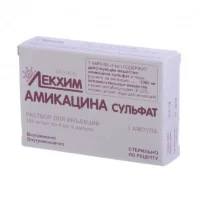Description
Floxium (Levofloxacin) Coated Tablets 0.5 g. №10
Composition
Active ingredient: Levofloxacin 0.5 g.
Other ingredients: Microcrystalline cellulose, crospovidone, magnesium stearate, hypromellose, titanium dioxide, polyethylene glycol.
Mechanism of Action
Levofloxacin, a fluoroquinolone antibiotic, exerts its bactericidal effect by inhibiting bacterial DNA gyrase and topoisomerase IV enzymes, thus disrupting DNA replication, transcription, repair, and recombination processes in susceptible pathogens.
Pharmacological Properties
Levofloxacin demonstrates a broad spectrum of antimicrobial activity against Gram-positive and Gram-negative bacteria. It penetrates well into tissues and achieves high concentrations in respiratory, urinary, and skin tissues, where it effectively combats bacterial infections.
Indications for Use
Floxium (levofloxacin) Coated Tablets are indicated for the treatment of bacterial infections such as acute sinusitis, community-acquired pneumonia, skin and soft tissue infections, complicated urinary tract infections, and pyelonephritis.
Contraindications
Do not use Floxium (levofloxacin) Coated Tablets if:
- You have a history of tendon disorders associated with fluoroquinolone use.
- You are pregnant or breastfeeding.
- You have a history of myasthenia gravis.
Side Effects
Common side effects of levofloxacin may include nausea, diarrhea, headache, dizziness, and insomnia. Rare but serious adverse reactions include tendon rupture, peripheral neuropathy, and Clostridium difficile-associated diarrhea.
Usage Instructions
Adults: The usual dosage of Floxium (levofloxacin) Coated Tablets is 500 mg once daily for 7-14 days, depending on the type and severity of the infection. Swallow the tablet whole with a full glass of water, with or without food. Do not crush or chew the tablet.
Benefits Compared to Analogues
Levofloxacin offers several advantages over other antibiotics, including its broad spectrum of activity, convenient once-daily dosing regimen, and proven efficacy in treating a variety of bacterial infections. Its favorable pharmacokinetic profile contributes to high cure rates and improved patient compliance.
Suitable Patient Groups
Floxium (levofloxacin) Coated Tablets are generally well-tolerated in adults, including the elderly population. However, caution is advised in pediatric patients and adolescents due to the potential risk of musculoskeletal adverse effects on growing bones and tendons.
Storage and Shelf Life
Store Floxium (levofloxacin) Coated Tablets in a cool, dry place at room temperature (20-25°C). Protect from moisture and light. Keep the tablets in their original packaging to maintain their integrity. Check the expiration date on the packaging and do not use the tablets beyond the stated shelf life.
Packaging Description
Floxium (levofloxacin) Coated Tablets are supplied in blister packs containing 10 tablets each. The packaging is designed to ensure the stability and protection of the tablets from external factors that could compromise their quality and efficacy.
Clinical Evidence and Proven Effectiveness
Levofloxacin has been extensively researched, with numerous clinical studies supporting its efficacy in treating bacterial infections. Clinical trials have demonstrated the high activity of levofloxacin against a wide range of pathogens, leading to successful outcomes in patients with respiratory, urinary, and skin infections.
In addition, the pharmacokinetic properties of levofloxacin allow for once-daily dosing, which enhances treatment adherence and overall therapeutic effectiveness.





